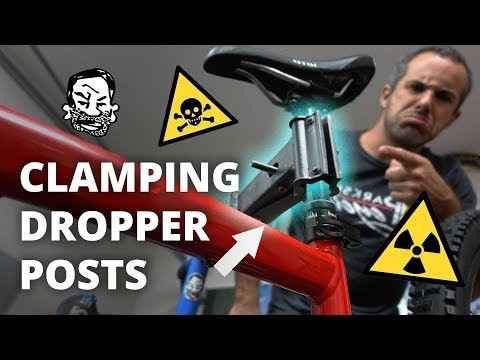bicycle repair … | Clamping your dropper post is no big deal
본문
※ 영상을 선명하게 보기 안내
- 유튜브 영상에서 오른쪽하단에 톱니바퀴를 클릭합니다.
- 팝업목록에서 "품질" 선택하세요.
- 원하는 해상도를 선택해주세요.
※ 모바일에서 Wifi가 아니라면 데이타가 소진될 수 있으니 주의바랍니다.
bicycle repair …님의 Bicycle Repair Tips강의 청각장애인을 위한 자막

It’s been raining nonstop, so we’re going
to talk about something different today.
Clamping dropper posts.
Many of us use a repair stand for wrenching
our bikes.
Most of these stands hold bikes by clamping
the seat post.
From there, the clamp can be locked into whatever
position is comfortable.
Repair stands like these have been used in
bike shops for many decades.
Except now, even mid end mountain bikes come
with dropper seat posts.
These rather expensive seat posts can be adjusted
from a switch on the handlebars, which gives
the rider the ability to get their seat out
of the way on the fly.
I personally think it’s the biggest improvement
to trail bikes since the suspension fork,
but that’s a topic for another video.
While they may seem like glorified office
chairs, dropper seat posts are pretty refined.
They’re compact and lightweight.
They’re designed to endure the stresses
of mountain biking, but it turns out those
stresses are much different from those inflicted
by a bike repair stand.
Let’s talk about how a stand can ruin your
dropper post, and some of the ways mechanics
deal with this.
First of all you should avoid scratching the
stanchion of your dropper post.
Scratches can cause abrasion on the seals,
which only worsen with use.
If your stand’s clamp is covered in dirt
from another bike, you could be forcing sand
and rocks directly into the surface of your
post, causing abrasions.
This could potentially ruin your post.
Also, bike stands can be locked into different
positions.
Even on a featherweight road bike, there’s
a considerable amount of force being put on
the seat post for it to stay in this position.
On a dropper post, that’s not good either,
especially when it’s done repeatedly for
long periods of time.
Sometimes you can avoid this altogether by
raising the post slightly and clamping it
on the body.
Some even clamp the collar, which seems like
a lot of stress to put on this little part.
I’ve also seen a shop towel thrown into
the mix to protect the stanchion.
Considering all the bad things that can happen
from clamping your dropper post, it’s no
wonder that people will generally tell you
not to do it.
There’s no guarantee that your jaws clean,
and you most certainly can’t be trusted
to clamp your bike in a stressless position.
That is, unless you clean your jaws and clamp
your bike in a stressless position.
In other words, it might be okay to clamp
a dropper post if you understand the implications.
Look, when you clamp your bike just leave
the stand loose.
The bike will fall into its natural position,
putting no appreciable lateral force on the
internals.
Sure, the bike is pulling on the post, but
that’s no big deal for one repair session.
In fact, demo bikes hang from their dropper
posts for entire seasons, and my bikes are
always stored that way.
This might not be so good though.
Nevertheless, I clamp my dropper posts, right
on the friggin stanchions.
But you didn’t hear it from me, you heard
it from Alex.
A lot of you are actual bike mechanics, so
chime in and let me know what you think.
Let’s have an argument.
Is this a lazy approach to bike repair?
Should you just always raise the post enough
to get the clamp on?
Where else can you clamp a bike, specifically
a carbon bike, without stressing an even more
expensive part?
Let me know in the comments.
Thanks for riding with me today, and I’ll
see you next time.


댓글 0개
등록된 댓글이 없습니다.